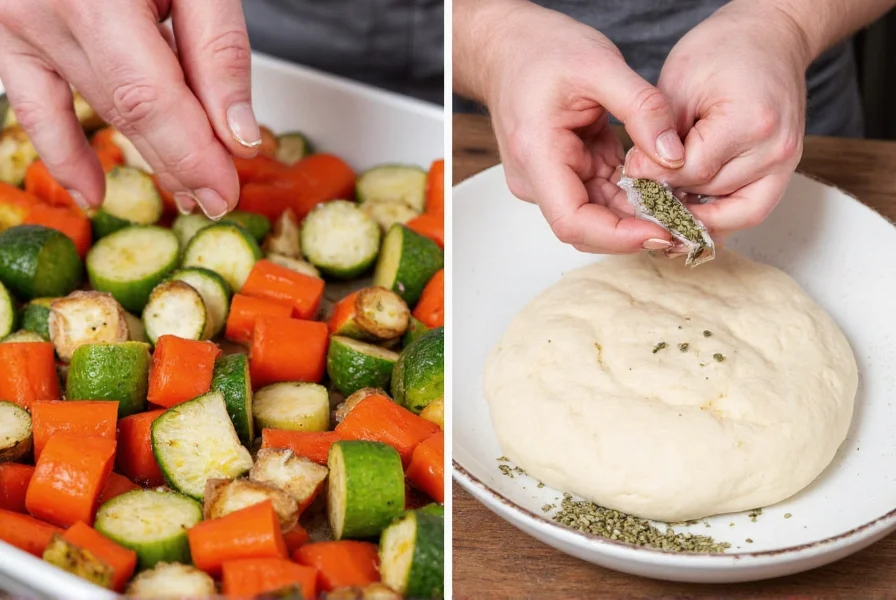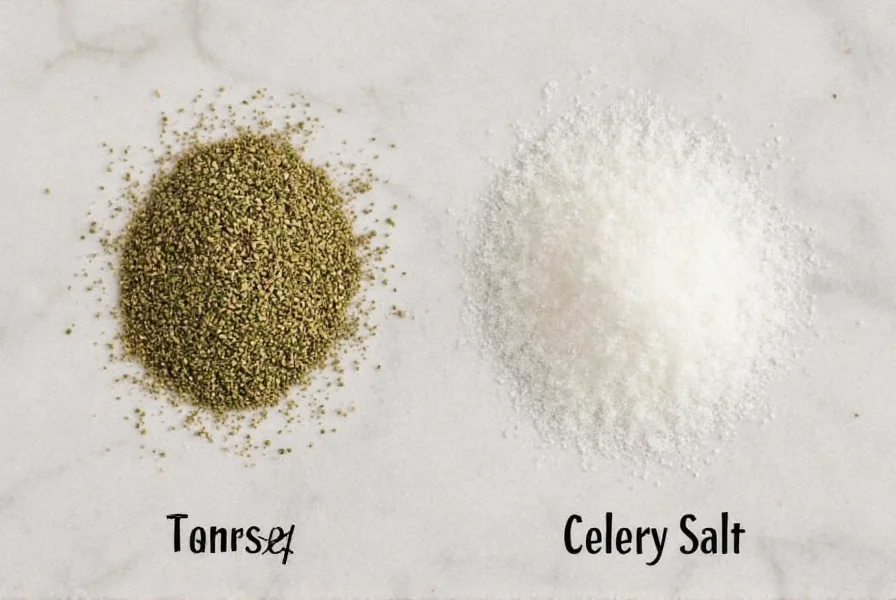Celery seeds are the dried fruit of the celery plant (Apium graveolens), while celery salt is a seasoning blend typically containing 75-80% salt and 20-25% ground celery seeds. The fundamental difference is that celery seeds are a single-ingredient spice, whereas celery salt is a compound seasoning combining celery seeds with salt and sometimes anti-caking agents.
Understanding the distinction between celery seed and celery salt is crucial for precise cooking and recipe execution. Many home cooks mistakenly treat these ingredients as interchangeable, which can dramatically alter the flavor balance and sodium content of dishes. This comprehensive guide explores their botanical origins, flavor profiles, culinary applications, and proper substitution methods to help you make informed decisions in your kitchen.
Botanical and Composition Differences
Celery seeds come from the Apium graveolens plant, the same species that produces the celery stalks familiar in grocery stores. These tiny, brown seeds contain concentrated essential oils that deliver celery's characteristic flavor. When harvested and dried, they become the single-ingredient spice known as celery seed.
In contrast, celery salt isn't a natural product but a manufactured seasoning. Commercial celery salt typically consists of:
| Component | Percentage | Purpose |
|---|---|---|
| Salt (sodium chloride) | 75-80% | Primary seasoning and preservative |
| Ground celery seeds | 20-25% | Flavor component |
| Anti-caking agents | Trace amounts | Prevent clumping (e.g., calcium silicate) |
Some artisanal versions may include additional ingredients like dried celery leaves or other spices, but the salt-to-seed ratio remains the defining characteristic.

Flavor Profile Comparison
The flavor difference between these ingredients is substantial due to their composition:
- Celery seeds: Intensely aromatic with warm, slightly bitter notes, earthy undertones, and a distinctive celery fragrance. The flavor is concentrated and potent—just 1/2 teaspoon can flavor an entire pot of soup.
- Celery salt: Primarily salty with subtle celery notes. The salt dilutes the celery flavor significantly, creating a more subtle seasoning that enhances rather than dominates.
When heated, celery seeds release their essential oils more readily than celery salt, making them better for dishes requiring extended cooking times. The salt in celery salt seasoning dissolves quickly but doesn't provide the same depth of celery flavor.
Culinary Applications and Best Uses
Understanding when to use each ingredient elevates your cooking precision:
When to Choose Celery Seeds
- Bread doughs and savory baked goods where salt content is carefully balanced
- Spice blends like Old Bay seasoning or pickling spices
- Vegetable stocks and broths where pure celery flavor is desired
- Cole slaw dressings and creamy dips where visible specks add visual interest
- Recipes already containing significant salt where additional sodium would be problematic
When Celery Salt Works Better
- Rubbing on meats before grilling or roasting
- Seasoning for Bloody Mary cocktails
- Finishing salt for roasted vegetables
- Adding to potato salad where both salt and celery flavor are needed
- Situations requiring quick seasoning without measuring multiple ingredients

Substitution Guide: Celery Seed vs Celery Salt
While not perfectly interchangeable, substitutions can work with careful adjustment. The critical factor is accounting for the salt content difference when swapping between these seasonings.
| If Recipe Calls For | Substitute With | Conversion Ratio | Additional Adjustments |
|---|---|---|---|
| 1 teaspoon celery seeds | Celery salt | 1½ teaspoons | Reduce additional salt by ¾ teaspoon |
| 1 teaspoon celery salt | Celery seeds | ¼ teaspoon | Add ¾ teaspoon salt separately |
Important substitution considerations:
- Texture matters: Whole celery seeds provide visible specks in dishes, while celery salt dissolves completely
- Flavor development: Celery seeds benefit from toasting before use to enhance flavor; celery salt shouldn't be toasted as the salt may burn
- Sodium-sensitive diets: Those monitoring sodium intake should prefer celery seeds and adjust salt separately
- Recipe timing: Add celery seeds early in cooking to develop flavor; add celery salt later to preserve its delicate aroma
Storage Recommendations
Proper storage maintains the flavor integrity of both products:
- Celery seeds: Store in an airtight container away from light and heat. Properly stored, they maintain peak flavor for 2-3 years. The essential oils gradually evaporate over time, diminishing potency.
- Celery salt: Also requires airtight storage, but has a longer shelf life of 3-4 years due to salt's preservative properties. Check periodically for clumping, which indicates moisture exposure.
Test freshness by crushing a small amount between your fingers. Fresh celery seeds should release a strong, pleasant aroma. If the scent is faint or musty, it's time to replace them.
Common Misconceptions Clarified
Several myths persist about these ingredients that deserve clarification:
- Myth: Celery salt contains actual celery stalks
Fact: It contains only ground celery seeds, not dehydrated celery stalks - Myth: Celery seeds are just smaller pieces of celery salt
Fact: They're entirely different products with distinct compositions - Myth: Celery salt is healthier than regular salt
Fact: Nutritionally, it's still primarily salt with minimal additional nutrients from the seeds - Myth: They can be used interchangeably without adjustment
Fact: Substituting one for the other without adjusting salt content will significantly alter sodium levels
Practical Recipe Applications
Understanding these differences transforms your cooking approach:
For a classic tuna salad, celery seeds provide visible specks and concentrated flavor without over-salting, as the recipe already contains mayonnaise and often additional salt. Use ¼ teaspoon celery seeds per 2 servings.
When making homemade potato chips, celery salt works better as a finishing seasoning because it adheres well to the surface and provides both salt and flavor in one step. Sprinkle lightly after baking for optimal results.
In bread baking, particularly rye or seeded breads, whole celery seeds contribute texture and pockets of intense flavor that celery salt cannot replicate. They're typically added at 1-2 teaspoons per loaf.
For cocktail rimming (like Bloody Mary glasses), celery salt creates the traditional seasoned edge that combines saltiness with subtle celery notes, while pure celery seeds would be too intense and visually unappealing.
Frequently Asked Questions
Can I substitute celery seed for celery salt in recipes?
Yes, but with important adjustments. Replace 1 teaspoon of celery salt with ¼ teaspoon celery seeds plus ¾ teaspoon regular salt. Without this adjustment, your dish will lack sufficient saltiness while still getting the celery flavor.
Which has more intense celery flavor: seeds or salt?
Celery seeds have a much more intense celery flavor than celery salt. Since celery salt is mostly regular salt (75-80%), the celery flavor is significantly diluted. You need about 4 times more celery salt to achieve the same level of celery flavor as pure seeds.
Is celery salt healthier than regular salt?
No, celery salt isn't significantly healthier than regular salt. While it contains small amounts of nutrients from celery seeds, it's still 75-80% sodium chloride. The nutritional difference is negligible, and both should be consumed in moderation as part of a balanced diet.
Why do some recipes specifically call for celery seeds instead of celery salt?
Recipes specify celery seeds when the chef wants concentrated celery flavor without additional salt. This is common in baked goods, spice blends, and dishes where sodium content is carefully controlled. The visible specks of seeds also provide visual texture that dissolved celery salt cannot.
How can I make my own celery salt at home?
Combine 1 part finely ground celery seeds with 3 parts fine sea salt. For 1 cup of celery salt, use ¼ cup ground celery seeds and ¾ cup salt. Grind the seeds in a spice grinder until fine, then thoroughly mix with salt. Store in an airtight container away from light and heat.











 浙公网安备
33010002000092号
浙公网安备
33010002000092号 浙B2-20120091-4
浙B2-20120091-4